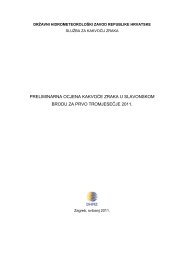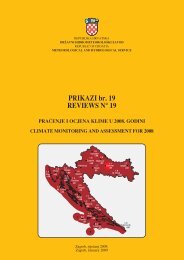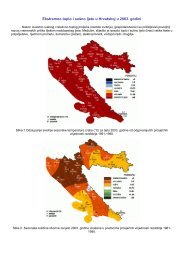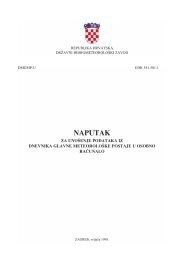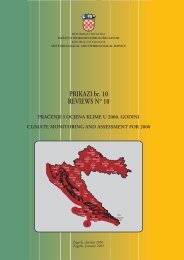CROATIAN CLIMATE OBSERVING SYSTEM
CROATIAN CLIMATE OBSERVING SYSTEM
CROATIAN CLIMATE OBSERVING SYSTEM
Create successful ePaper yourself
Turn your PDF publications into a flip-book with our unique Google optimized e-Paper software.
<strong>CROATIAN</strong> <strong>CLIMATE</strong> <strong>OBSERVING</strong> <strong>SYSTEM</strong> 17<br />
Meteorological radar station, Bilogora, MHS, Croatia<br />
- Automatic meteorological stations not linked to the MHS IT system are set up individually<br />
or to serve different systems (e.g. roads, agriculture, forestry, the power industry,<br />
tourism, etc.). Besides air temperature, humidity and pressure, precipitation and weather<br />
type (current weather) they measure a number of additional variables, e.g. road-surface<br />
state (dry, wet, dry with salt, wet with salt, moist, covered by ice, black ice or frost and<br />
cover depth), oceanographic variables, air pollution elements, plant disease development<br />
conditions etc. Such stations are usually located at sites not representative of the area and<br />
are used for operative application in different user fields.<br />
4.1.2 Upper-air stations - activities and organisation<br />
- Radio-sonde stations perform measurements of upper-level air pressure, temperature<br />
and humidity and wind speed and direction in the 0-35 km layer. At the Zagreb-Maksimir<br />
radio-sonde station, measurements are carried out twice a day (00 and 12 UTC) by the<br />
Vaisala Digi Cora II automatic device and using the NAVAID LORAN C system to define<br />
wind speed and direction. The balloons are manually prepared, inflated and launched by<br />
professional observers. At the Zadar radio-sonde station, measurements are performed<br />
twice a day (00 and 12 UTC) by the completely automated Vaisala AUTOSONDE able to<br />
handle 12 radio-sonde measurement. A GPS is used to define wind velocity and direction.<br />
The balloons are inflated and launched automatically. Balloons are replaced and hydrogen<br />
checked once a week. Data are controlled within their own algorithm and are automatically<br />
stored in computerised form.<br />
Spatial distribution meets WMO requirements<br />
- Pilot-balloon stations measure wind velocity and direction by optical theodolite twice a<br />
day, at 06 and 18 UTC, if weather conditions permit. Data are recorded in observation<br />
logs.



